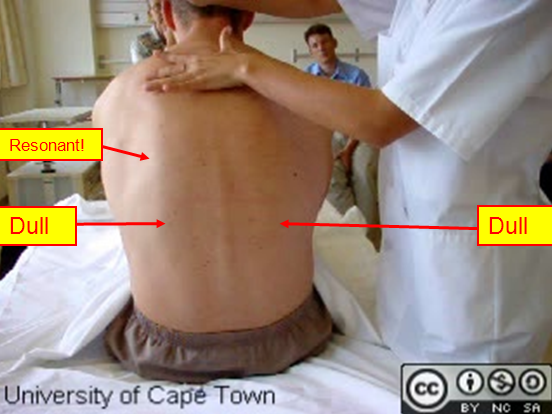Percussion
| AFRIKAANS | TRANSCRIPT | XHOSA |
|---|---|---|
| I?m now going to tap your chest. / Ek gaan nou u borskas beklop. / Ngoku ndizakubetha kancinci esifubeni. | ||
| Tell me if it?s painful. / S?vir my as dit seer is. / Ndixelele ukuba kubuhlungu. |
With percussion, the intention is to distinguish resonance from dullness: a resonant sound suggests underlying air, whereas dullness suggests a solid substratum ? either fluid or consolidated lung.
Technique is important. It is essential that the finger which you lay across the chest is stretched absolutely tight ? the knuckles should be white.
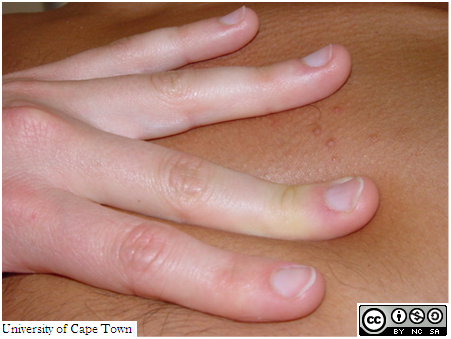
Stretch your finger across the chest, ensuring that it lies in the interspace between ribs ? not across or over the ribs. Make sure the knuckle is pressed flat.
Swing the other hand from the wrist, rather than jabbing with the whole forearm. Make a curved ?hammer? of your index and middle fingers.
Now percuss firmly with one or two fingers of the other hand. You must obtain a loud, easily audible sound!
Is your percussion this loud and confident? It should be.
As you percuss, proceed down the chest anteriorly, comparing left side with right side. First percuss over the clavicle. Then percuss about 4 positions on each side anteriorly, sweeping from medial to lateral below the breast.
Finally percuss over the lateral wall of the chest. In women, swing round the medial side of the breasts, slide your hand beneath them if necessary and continue percussing.
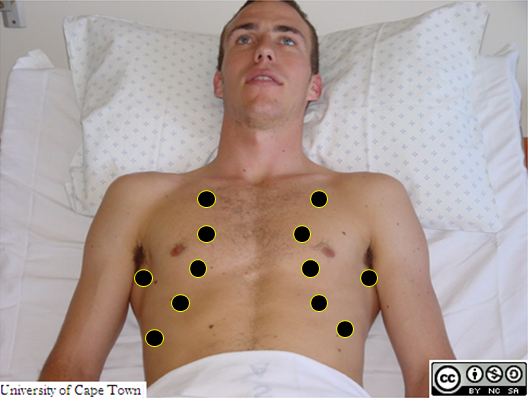
Proceed calmly and methodically. You can percuss directly on the clavicle, without an interposed finger. It is not necessary to ?knock? more than twice in each spot. Make sure that every ?knock? is loud and confident.
| AFRIKAANS | TRANSCRIPT | XHOSA |
|---|---|---|
| Breathe normally while I do this. / Haal normaal asem terwyl ek u borskas beklop. / Phefumla ngokwesiqhelo lomzuzu ndenza oku. | ||
| Thank you. / Baie dankie. / Enkosi. |
Did you hear the dullness over the lower anterior chest on the right, due to underlying liver dullness? Listen again.
End by percussing on the lateral chest wall, about midway down the chest. If indicated, one can percuss high in the axilla as well. Make sure that every ?knock? is loud and confident.
It is necessary to move towards the foot of the bed and to swing the left arm as shown below in order to obtain a confident and elegant technique.
| AFRIKAANS | TRANSCRIPT | XHOSA |
|---|---|---|
| Move your arm a little please. / Skuif u arm ?n bietjie weg. / Ndicela ubhekelise ingalo kancinci. | ||
| When I?m finished, I?ll help you to sit up. / Wanneer ek klaar is, sal ek u help om regop te sit. / Xa ndigqibile, ndizakukuncedisa uhlale nkqo! |
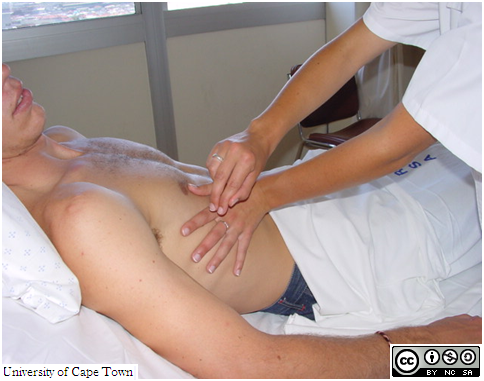
Now watch how this is done. Our examiner will complete the lowest percussion notes on the anterior chest wall and then move to the lateral wall.
Now percuss posteriorly. Proceed down the chest posteriorly, comparing left side with right side. Percuss about 4-5 positions on each side. Higher up, percuss closer to the spine to avoid the scapulae. As you move lower down, sweep out laterally.
| AFRIKAANS | TRANSCRIPT | XHOSA |
|---|---|---|
| I?m going to do the same on your back. / Ek gaan dieselfde op u rug doen. / Ndiza kwenza ngokufanayo emqolo. | ||
| Please sit up and lean forward. / Sit asseblief regop en leun vorentoe. / Ndicela uhlale nkqo. |
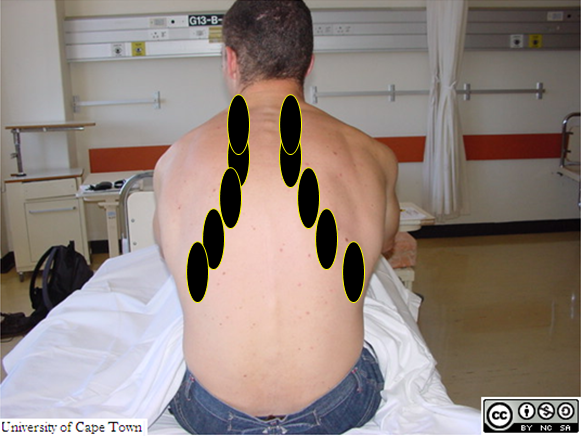
Proceed calmly and methodically. It is not necessary to ?knock? more than twice in each spot. Make sure that every ?knock? is loud and confident.
Watch how this is done.
Did you hear the note become dull near the bases, as one leaves the lungs and begins percussing over the abdominal contents?
Listen again. Percussion over the three higher sites produces a resonant note: over the left lower chest, a dull note.
